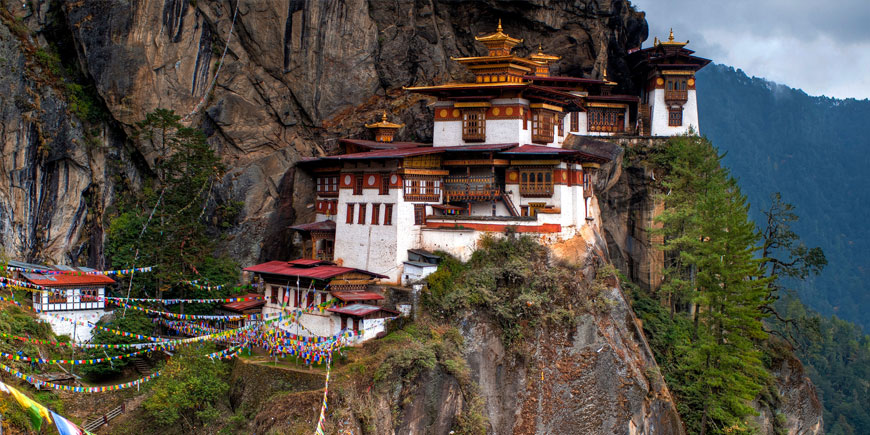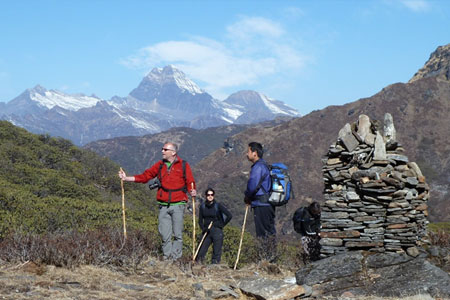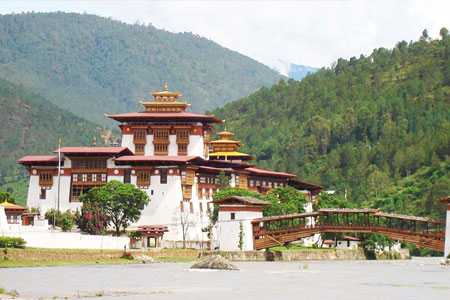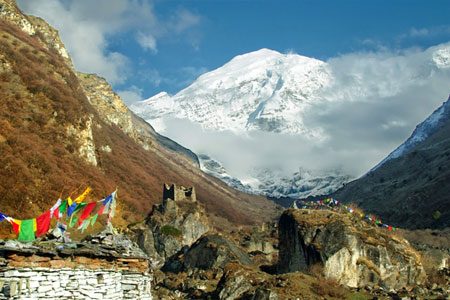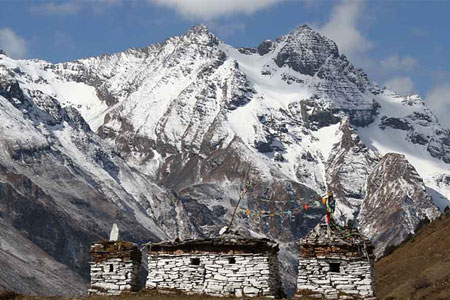Drukyul, the kingdom of Bhutan is a land of the thunder dragon. Situated between China to the north and India to the south, it is a land of immense natural beauty with a rich ancient culture and tradition. Bhutan has practiced a controlled tourism. It is one of the few unexplored tourist destinations in the world. Bhutan is often referred to, as Shangri La. Buddhism is the national religion of Bhutan. It is believed that Buddhism was first introduced in the 8th century. The Bhutanese people love themselves to be called Drukpas.Dzongkha is the national language of Bhutan. The Tibetan origin people dominate the northern, eastern and western part of Bhutan while the Nepalese origin people dominate the southern part. Bhutan was opened to the modern development in the 1960s after the years of self-imposed isolation with the building of the first schools, hospitals and roads. When Bhutan was closed to the outside world, the then Bhutanese government took these Nepali origin people to accelerate the development process. However, it is pity to say that more than 1, 00,000 Nepali origin Bhutanese people have been taking asylum in eastern districts of Nepal due to political crisis in Bhutan. In the new millennium, Bhutan stands as a unique nation that blends modernization with its tradition and culture.
History of Bhutan
Bhutan, being a landlocked country; her history has always been influenced by its geography. The historical legends of Bhutan begin with the visit of Guru Padmasambhava, who is believed to have come from Tibet in 747 A.D. After his arrival in the dragon kingdom, the Buddhist faith has played a large part in shaping the course of this country's history. The word "Bhutan" is derived from the Sanskrit word "Bhu Uttam" which means best soil. No doubt, Bhutan's soil is recognized as one of the best among the South Asian Association for Regional Cooperation ( SAARC) countries. The early explorers and envoys of the British government used to call "Bootan" .The Buddhists writers called her "Lho Mon" or "Mon Yul" which means "Paradise of the South" and "Land of the Moons" respectively. It is Druk or Druk Yul, Land of Thunder Dragon etc. to the inhabitants of Bhutan. From the available and surviving literatures and artifacts in a few ancient monasteries, the prehistoric era of Bhutan can still be traced to 500 to 600 A.D .Its unique geographical situation secured it free from foreign authority and allowed it to develop a strong degree of common identity despite the ethnic and linguistic diversity of its inhabitants.The 17th century traced the unification of Bhutan under the charismatic leadership of Nawang Namgyal who took the honorary title of Shabdrung. In 1865, the Penlop of Tongsa named Jigme Namgyel bequeathed his son Ugyen Wangchuk that position.Thus, the Wangchuk dynasty has been ruling this small kingdom till the date. King Jigme Singe Wangchuk is the present king of Bhutan.
Flora and Fauna
Bhutan is best known for rich flora and fauna. Your journey to Bhutan holds the promise of a deep and refreshing communion with nature in its varying beauty. Rhododendron, Junipers, Magnolias, Orchids, Gentians, Daphne and the rear Blue Poppy and other some rare medicinal herbs and exotic mushrooms include the flora available in Bhutan.
There are over 500 species of birds available in Bhutan. Monal Pheasant, the Tragopan, wild Pigeons and doves, the rare Rufus- necked hornbill and the endangered Black-necked crane are the major fauna available in Bhutan. The population of butterfly fauna is abundant in Bhutan. Bhutan holds a rich wildlife like- Snow leopard, Blue sheep, Musk deer, Takin, the Himalayan Black Bear, Tiger, Rhinoceros, Gaur, the Great Indian Water Buffalo, the Golden Langur and much more. Local fish and brown trout can be found in the northern river and the mountain lakes while Mahseer can be found in the south-east rivers.
People and culture
The people of Bhutan are hardworking, simple, warm and open.Bhutan's people fall into three broad ethnic groups. The Sharchops, Ngalungs and the Nepalese. The Sharchops are believed to have been the earliest inhabitants of the country. Majority of them have been living in the eastern region. The Nagalungs are the descendants of Tibetan immigrants who came to Bhutan from about the 9th century onward.They have been sheltering primarily in the western part of Bhutan. The third section of population are the Nepalese.They are living in the southern belt of Bhutan.When Bhutan was closed to the outside world, when there was null development in Bhutan, these Nepalese origin people were taken by the Bhutanese government to accelerate the developmental activities in Bhutan. However, it is pity to say that more than 100,000 Nepali origin southern Bhutanese were evicted from their own homeland by the Bhutanese government on charge of demonstrating for democracy and fundamental human rights and currently, they have been sheltering in seven refugee camps in Jhapa and Morang districts of Nepal.The southern Bhutanese are the followers of Hinduism while the Sharchops and Ngalungs follow Buddhism. The national language of Bhutan is Dhongkha and its national religion is Buddhism. Agrarian life style is led by three-fourth of the population of Bhutan. Still the culture and social life is unhampered by the fast life that marks modernity.
The men's attire is called "Gho" while "Kira" is the attire of women. However, the Nepalese origin people wear"Gho" and "Kira" only when visiting offices. Jewellery is mostly of pearls, corals turquoise, and agate set in well-crafted gold and silver.
Meat, cereals particularly rice, vegetables and herbs are the major foods of Bhutan.
Meat dishes include mainly goat, pork and beef, which are lavishly spiced with chillies. Salted butter tea is served to all the visitors at the first entrance to any house.Other famous beverages include Chang, a local beer, and Arra, a spirit distilled from rice, maize, wheat or barley. As a customary greeting, "Doma" or betel nut is offered to every visitor.
Archery is the national game of Bhutan. It holds much popularity throughout the nation. The Bhutanese people play it with zeal and enthusiasm all year round with the traditional bows and arrows. In Bhutan, the ancient and traditional art, music and dances of the different ethnic groups are faithfully protected and preserved
Festivals of Bhutan
In this dragon kingdom, Tshechus are the main annual religious festivals of Bhutan that are celebrated to honour Guru Padmasambhava, also known as "Guru Rimpoche". Tshechus are considered as an occasion for reverence, feasting, socializing and blessing by the people. Staged at different times of the year in different parts of the Kingdom, Tshechu is a unique experience to the outsider. Apart from Tshechus, Dashain and Tihar are also celebrated in Bhutan .Primarily, Dashain and Tihar are celebrated by the Nepali origin Bhutanese people.
Art and Craft
The people of Bhutan have a strong sense of aesthetics, art, craft and architecture. Primarily, Bhutan's art and craft is broadly influenced by the Tibetan art and craft.Dzongs, chortens and monasteries can be seen elsewhere.Some of the Lhakhangs and Gompas are even made on high peaks. Chortens are basically constructed in memory of an eminent lama or to ward off evil spirit. These structures are beautifully decorated inside and out with woodcarvings and paintings in a riot of colours and patterns.
The walls of temples and shrines are decorated with the paintings and carvings of Buddha and various deities. The " Tashi Tagye" or eight auspicious signs are found painted on buildings.Thankas are hung on the walls for attractions. They offer the Thanka as souvenir when tourists pay their visit. Articles for daily use are not touched by the influence of modernization and commercialization. Traditional craftsmanship has been handed down from generation to generation. Craftsmen of Bhutan are skilled in bronze and precious metals, wood and slate carving and clay sculpture.

